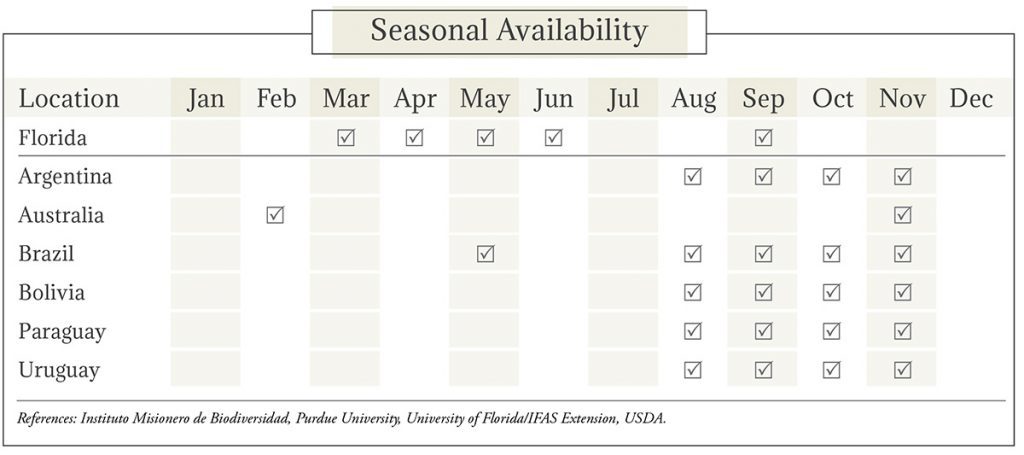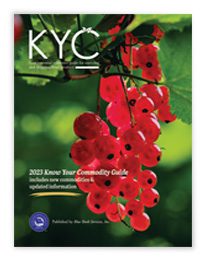Jaboticaba Market Summary


Image: RHJPhotoandilustration/Shutterstock.com
Jaboticaba Market Overview
Jaboticaba (Myrciaria cauliflora) is a fruit from South America, also known by the slightly varied names of jabuticaba and yabuticaba. Similarly, the trees from which these fruits grow are called jaboticabeira, as well as the Brazilian grape tree. Jaboticaba trees grow wild in several locations: the hills of Argentina, Bolivia, Brazil, and Paraguay; coastal forests near the Brazilian cities of Rio de Janeiro and São Paulo; and various other types of environments in places such as Peru and Uruguay. They have been introduced in both Central and North America, in California, Florida, Hawaii, Colombia, Cuba, Honduras, and Panama. Additionally, the trees were introduced to Australia. Along with fruit cultivation, they are raised for ornamental and medicinal purposes.
Types & Varieties of Jaboticaba
A handful of different species of tree fruit fall under the jaboticaba umbrella, grouped together due to their similarities. These include Myrciaria cauliflora, Myrciaria jaboticaba, Myrciaria tenella, and Myrciaria trunciflora. The fruit has a smooth yet durable skin, in red, purple, or black when ripe, and green beforehand. While the skin is edible—tasting somewhat acidic and spicy—the pulp is the real draw. The inside is translucent white, sometimes tinged pink, full of juice and a couple of seeds. Seeds should be discarded before the berry is eaten. Jaboticabas have a sweet taste, like a grape, though they are occasionally resinous and bitter. The berries are primarily eaten raw, but they can be made into preservatives, such as jams and marmalades, if thickeners are added and the skins removed (the skin contains tannin, which is carcinogenic). Jaboticaba fruit is also used to make ice cream, juice, liqueurs, sauces, syrup, and wine, or used as colorants. Commercial varieties include Branca, Grimal, Mineira, Murta, Paulista, Roxa, and São Paulo. The Sabará variety is the most popular, the fruit being small, thin-skinned, and sugary. The Rajada variety is bigger, with green-bronze skin, but still sweet in taste. Another variety, Ponhema, can only be eaten raw when it is fully ripe, so it is more often grown for the making jellies and jams.

Cultivation of Jaboticaba
Jaboticaba trees have many branches, bunched closely together. With ample room to grow, branches reach up and out, achieving a height of up to 40 feet and a circular spread as wide as 45 feet. Occasionally, jaboticabeiras feature several trunks; the reddish-brown tree bark is thin, with pale gray spots beneath, which get revealed when the outer material flakes away. Their rough and shiny dark-green leaves, salmon-colored when young, are retained all year round. White flowers blossom and round fruit can either be clustered or dispersed. Flowering occurs intermittently throughout the year, especially in late winter and spring. Flowers and fruits emerge out of branches and trunks alike. The trees thrive in moist, rich, slightly acidic soil with a pH value between 5.5 and 6.5. Soil should have some sand, plenty of depth, and good drainage. Salt is harmful to the plant, but jaboticabeiras can adapt to other materials like grainy limestone. Too much water is detrimental, but moisture should still be readily available. In natural habitats, the trees fair well from as low as sea-level, to as high as 4,000 feet above. Warmer weather is ideal, although even freezing temperatures can be tolerated for short amounts of time; still, branches and leaves may be damaged. For optimal growth, temperatures should remain above 27°F, and full sun is needed during the day, so tropical climates are ideal. Seeds will germinate between 20 and 40 days after planting, each one producing a handful of plants. Some weeding may be needed around saplings. Air-layering, tissue culture, or grafting are also options. Due to sensitive roots, jaboticabeiras are not fertilized. Maturation is slow, trees can take from 8 to 15 years to bear fruit. Grafted trees can be exceptions, producing fruit in 7 years or slightly less. Once flowering starts, it takes 20 to 25 days to develop mature berries, which should be picked within days. Individual jaboticaba berries are only a few inches long and relatively lightweight, however, hundreds of berries—as much as 100 pounds or more—may be grown from a single tree on at seasonal peaks.

